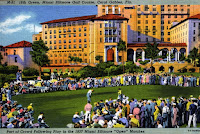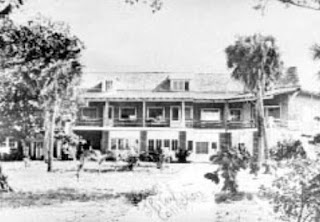 |
| Deep Sea Fishing advertisement Florida State Archives/Florida Memory circa 1930 |
Visitors knew before Fort Lauderdale was officially established it offered great fishing. Fishing yarns would be exchanged in the late 1890s and early 1900s at the Stranahan Trading Post on the New River and aboard the settlement's first party houseboat, the Wanderer.*
In 1930, the Fort Lauderdale Daily News praised the city's fishing opportunities:
People fish everywhere in Fort Lauderdale--from any of its countless bridges, from city docks in the heart of the business section, from the jetties--and with equal success, property owners of waterfront homes have been known to make record catches ... standing in their own front yards.
There were few tales about the fish that got away because they didn't. The fish count was the story.
Amidst the city's growing fishing reputation, which included the tale of a whale**, deep sea fishing charters emerged as a viable and growing business during the 1930s. Advertisements for deep sea fishing on the "Cruiser Joy" first appeared in Fort Lauderdale in 1939.
The vessel, docked at the Andrews Avenue Bridge, was owned and operated by Captain Darcy Willis. Several hours fishing aboard a boat for $2 with bait and tackle ... a bargain even then. Willis was already known as a sports fishing guide in Morehead City, North Carolina where he won a few fishing tournaments.
His name and his next boat, Joy II, also appeared in local newspapers in 1940. News acccounts track his fishing exploits from Fort Lauderdale to the Saint Lucie River. He and his fishing passengers caught kingfish, amberjack, sailfish and at one time a reporter wrote, a 322-pound sunfish. By the late 1940s it appears Willis was operating once again in Morehead City. He seems to have droppd off the Fort Lauderdale radar after that.
Another popular charter fishing boat of that decade, the Reel Lucky, owned and operated by Captain Reuben Munroe, garnered media attention in the late 1930s with news about several large "hauls" of fish.
From informal fishing trips to charter fishing excursions, to rodeos that drew competing anglers during the 1930s (and today), fishing in Fort Lauderdale remains a popular pastime and sport. The fish, however do not remain as plentiful, but hope for a good catch springs eternal.
* For more on the Wanderer, see search box
** For the whale tale see search box.
Copyright © 2022 All rights reserved. Jane Feehan
Sources:
News and Obsever (Raleigh), Aug. 20, 1930
Fort Lauderdale Daily News, Dec. 1, 1930
Fort Lauderdale News, March 25, 1935
Fort Lauderdale Daily News, March 4, 1939
Fort Lauderdale Daily News, Feb. 22, 1940
News and Observer, April 26, 1948
Tags: About Fort Lauderdale, Fort Lauderdale fishing, Fort Lauderdale history, History of Fort Lauderdale, Fort Lauderdale charter boat fishing, deep sea fishing







.jpg)

.jpg)





